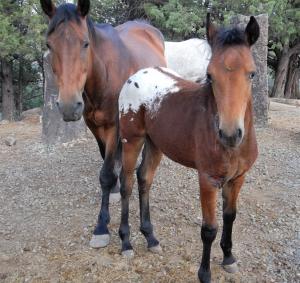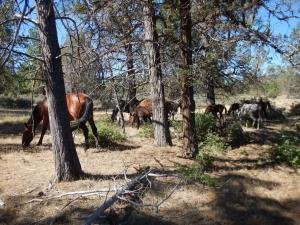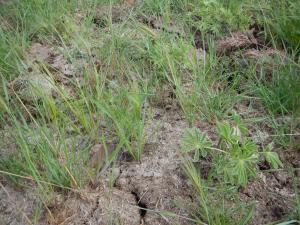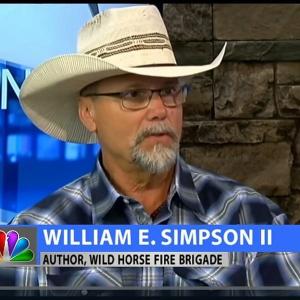
Genetic viability is at risk in American wild horse herds; using contraception is exacerbating that problem placing the species at risk of genetic bottleneck.

Wild horses are symbiotic to forests. The photo shows a family of wild horses that is reducing wildfire fuels on the forest floor. Reduced wildfire fuels results in less heat produced during a wildfire.

Wild horses are natures reseeding experts, as seen in this photo of grasses and plants springing-forth from wild horse droppings. Unlike ruminants (cattle, sheep) that digest virtually all the native seeds they consume, wild horses pass a significant portion of seeds
Are some wild horse nonprofit advocates violating the intent of the 1971 Free Roaming Wild Burro and Horse Protection Act by harassing wild horses with firearms
“What is ignored by the pro-PZP community is that wild horses darted with PZP to inhibit their ability to naturally reproduce aren’t really, well, “wild” anymore. “Wild,” means “living in a state of nature” as opposed to being “tamed or domesticated” to be more useful to humans. Accordingly, opposition to PZP is based on an ethical belief that wild animals should be free of human manipulation.”
William E. Simpson II, a naturalist who lives-among and studies free-roaming wild horses in a mountain wilderness area on the Oregon-California, has recently revealed information key to understanding how the use of contraceptive darting of wild horses and burros violates the intent of the preamble to the 1971 Free Roaming Wild Burro and Horse Protection Act.
That Preamble states:
“Congress finds and declares that wild free-roaming horses and burros are living symbols of the historic and pioneer spirit of the West; that they contribute to the diversity of life forms within the Nation and enrich the lives of the American people; and that these horses and burros are fast disappearing from the American scene. It is the policy of Congress that wild free-roaming horses and burros shall be protected from capture, branding, harassment, or death; and to accomplish this they are to be considered in the area where presently found, as an integral part of the natural system of the public lands.” [emphasis added]
Clearly, the intent was not to have herds of wild horses and burros artificially managed as if they are livestock:
“Non-profit wild horse activists and their organizations who condone or support the policy of chasing wild horses around the landscape and shooting them with high-powered firearms containing chemical contraceptive darts weighing 500-grains or more, are indirectly culpable in what is arguably harassment of wild horses”, said William E. Simpson II, the author of ‘Wild Horse Fire Brigade’, a new plan to save wild horses via re-wilding them in a humane manner that is both ecologically and economically appropriate.
There is no doubt that physical trauma is inflicted upon wild horses and burros via shooting them with firearms using contraceptive darts
Comparing the projectile weight of an average contraceptive dart to that of the world’s most powerful handgun, the Smith & Wesson .500 magnum; the S&W .500 magnum shoots projectiles (bullets) weighing from 265-grains up to a 700-grain projectile.
Contraceptive (PZP and GonaCon) filled darts weigh 500-grains and heavier!
"Even on a large animal struck correctly, the dart (contraceptive PZP and GonaCon darts) can cause hemorrhage and hematoma. Misplaced shots can break bones or even kill the animal” (Thomas and Marburger 1964).
“Report--Muzzle report can cause problems in darting either captive or free-ranging animals. In captive situations, the noise can be more disturbing to animals than getting struck with a dart.”
“Disturbed animals are then more difficult to approach, or the entire group of animals may run away". (Page 32; Overview of Delivery Systems for the Administration of Contraceptive to Wildlife”, by Terry J. Kreeger
The use of any contraceptive chemicals on wild horses is in fact a form of ‘selective breeding’. Horses that are treated, cannot have foals, while the untreated do have foals. And the person pulling the trigger decides which mares (and genes) are selected.
The act of choosing which animals get to breed and which do not, is ‘selective breeding’, and that is part of domestication. In some cases, the decision is based upon a horses’ appearance in the eyes of a person engaged in shooting horses, or which horse is a convenient target. And even with a genetic analysis of the target horse(s), it is still; a form of selective breeding.
The use of the contraceptive chemicals known as ‘PZP’ and ‘GonaCon’ have a seriously adverse effect on the gene-lines of native species American wild horses.
The results of using PZP and/or GonaCon to control populations of equids, kept in artificially managed herd areas with collapsed trophic cascades (natural predators of equids are largely missing), disintermediates the essential evolutionary process of ‘Natural Selection’, where co-evolved predators weed-out the sick, elderly and diseased animals.
Craig Downer a wildlife ecologist and wild horse expert had this comment:
“My investigation of PZP’s effects on wild horses has revealed serious harmful consequences. These include increased stress, discontent both in mares and stallions, consequent social disruption and dysfunction in the horses’ social unites, or bands, and the resulting decline in fitness and the ability to survive. Also, very serious weakening of the immune systems of PZP-treated horses, since those wild mares least affected by PZP are those with weaker immune systems, so they reproduce more. Basically, it is a very invasive form of domestication and as such, contrary to the true core intent of the 1971 Act.”
Mr. Simpson further stated that: “Keeping (managing) wild equids commingled with livestock in herd areas where their co-evolved predators have been depleted or are missing, is doing wild equids an ecological and genetic disservice and is actually mismanaging them.
In a recent letter (email) to pro-PZP advocates Marty Irby and Scott Beckstead of Animal Wellness Action, Mr. Simpson challenged either one or both of them to have a live public debate on the issues of PZP in regard to wild horse management.
New research suggests that chemical contraceptives (PZP and GonaCon) cause genetic erosion over time, and social disturbances in family bands, as well as other adverse effects (aborted foals, etc.). Dr. Cassandra Nunez PhD has published studies outlining the issues.
“Wild horses and burros must be allowed to live naturally ‘wild and free’ in a ‘natural system’ on public lands pursuant to the intent of the 1971 Act. That vision can still be sustainably realized via an amendment to the 1971 Act, that would allow the Bureau of Land Management and United States Forest Service to re-wild and relocate American wild horses into defined ‘wilderness areas’ that are both ecologically and economically appropriate” said William E. Simpson II
About; Craig Downer:
Craig Downer is a member of the International Union for Conservation of Nature (IUCN) Species Survival Commission (SSC). He wrote an action plan and species description for the endangered Andean Tapir for the IUCN SSC Tapir Specialist Group. He is an advisor to IUCN SSC’s Equine Specialist Group. He is a member of the American Society of Mammologists, and co-author of their special Mammalian Species Mountain Tapir publication. His website is at: https://andeantapirfund.com/about/
About; William E. Simpson II:
William E. Simpson II is a naturalist/rancher living among and studying native species American wild horses. Mr. Simpson is a recognized expert on wild horse behavioral ecology and their management by numerous county and federal officials. Mr. Simpson is the author of a published Study (‘Impact of Wild Horses On Wilderness Landscape and Wildfire’) showing the benefits wild horses provide to ecosystems. He’s the author of two published books and more than 100 published articles on subjects related to wild horses, wildlife, wildfire, and public land (forest) management. He has appeared on NBC NEWS, ABC NEWS, theDoveTV and has been a guest on numerous talk radio shows including the Lars Larson Show, the Bill Meyer Show, and on NPR Jefferson Public Radio. His website is at: www.WHFB.us
Willliam E. Simpson II
Wild Horse Ranch Productions
+1 858-212-5762
gemmaster7@aol.com
Fuel Fire and Wild Horses















